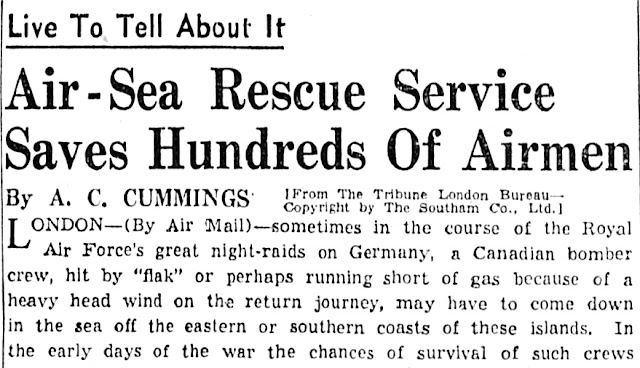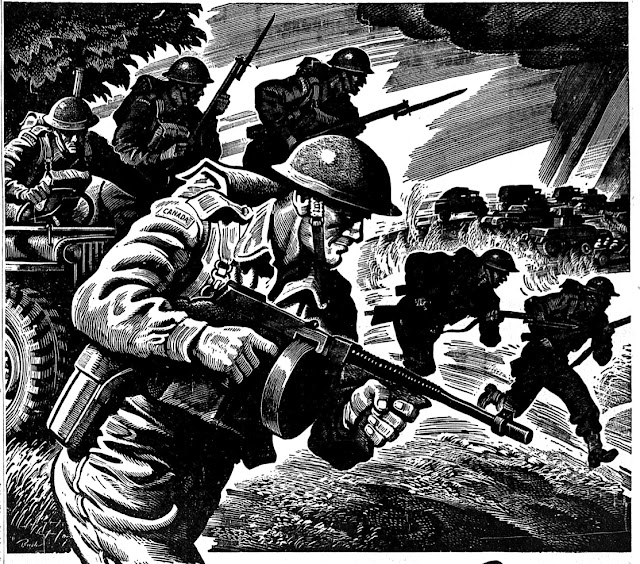Mock Battles, Hoarding Sugar and Smoking Free Cigarettes.
News From The Winnipeg Tribune, July 1 and 2, 1942.
Canadian infantrymen disembark from a landing craft in England during a training
exercise before Operation Jubilee, the Raid on Dieppe, France, in August 1942.
Photo Credit - Library and Archives Canada (MIKAN 3194482)
Library and Archives Canada Blog (LACB) - https://thediscoverblog.com/2017/08/19/the-raid-on-dieppe-france-august-19-1942/
Introduction:
By July 1 - 2, 1942, the dates the news articles and accompanying photographs (and editorial cartoons, and Coca-Cola ads, etc.) reached the Canadian public in and around Winnipeg, the first 100 Canadians enlisted in RCNVR and (also voluntarily) in Combined Operations had participated in training activities aboard various types of landing craft, as depicted in the top photo.
(That being said, the first 100 would likely have been more familiar with the smaller Landing Craft, Assault (LCAs) and Landing Craft, Mechanized (LCMs) rather than the larger crafts seen above, possibly early Landing Craft, Tank (LCTs). I am willing to listen to the opinions of others in this matter).
The Canadian sailors had arrived at ports on England's southern coast in late June, early July aboard such ships as the Ennerdale, and according to Navy memoirs they had been knocked about by German planes (e.g., Junkers or J88s) but survived to tell the tale. (Link to the account by Lloyd Evans, formerly of Markham, Ontario).
Later they prepared for Operation RUTTER, the first running of the Dieppe raid (July 7), and after that - Operation JUBILEE.
News articles and more, from The Winnipeg Tribune, provide reminders of the history of those early days in World War II, and context for the actions that come later in that year.
* * * * *
Calls for a Second Front (in Western Europe) have been linked to reasons why the Dieppe Raid was organized. Many books exist re the raid and have been listed in another section on this website. (See right hand margin, > 'click on HEADINGS', > books re Combined Operations).
A later article in this set seems to predict the upcoming action!
The next article is lightly linked to the Dieppe Raid. It has been written that Canadian POWs of the raid were handcuffed or chained in place in their barracks, reportedly in retaliation for something similar Allied forces had done to German prisoners. Were both side keeping a list, checking it twice?
Much has been written about the rationing that took place in Canada and abroad during the war. The next article and cartoon touch on the subject of 'the dark side' of hoarding the rationed items:
The next article reminds us that "behind the scenes roles" (i.e., away from the front lines) played a very significant part during WW2. Some say, "There were no small roles."
Over the last few years, as I've looked at many photographs of groups of soldiers, sailors, etc., I have noticed the proliferation of cigarettes hanging from lips and held between two fingers. Smokes were everywhere.
My father wrote about picking up cartons of cigarettes before going on leave, sometimes 800 smokes at one go (4 cartons).
Many men came home with a tough addiction to battle, along with other bad habits. There's a longer story in there somewhere!
Image is a screen capture from a video re Operation TORCH. There are four
recognizable Canadians in Combined Ops, dark sweaters (centre).
C. Powers, right of centre, is ready to light up!
The art work in some ads was strikingly good. In six weeks, the Dieppe Raid would tell another striking story.
Was PM King 'in the know' about Operation RUTTER, and later Operation JUBILEE? The 'van of attack' was fives days away, if he is referring to RUTTER (later cancelled, on the day of attack).
More articles that have some small connection to Canadians in Combined Operations will follow.































No comments:
Post a Comment